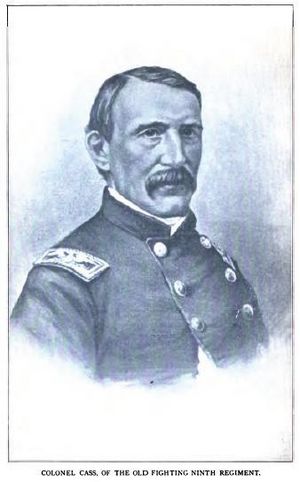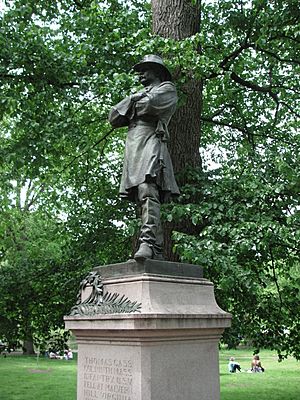Thomas Cass (colonel) facts for kids
Quick facts for kids
Thomas Cass
|
|
|---|---|

Colonel Thomas Cass
|
|
| Born | 1821 Farmly, Queen's County, Ireland |
| Died | July 12, 1862 (aged 40–41) Boston, Massachusetts, U.S. |
| Place of burial |
Mount Auburn Cemetery
|
| Allegiance | Union |
| Service/ |
|
| Rank | |
| Commands held | |
| Battles/wars | American Civil War |
Colonel Thomas Cass (born 1821, died July 12, 1862) was an important leader during the American Civil War. He started and commanded the 9th Regiment Massachusetts Volunteer Infantry, a group of soldiers in the Union Army. This regiment was very active in many battles. Colonel Cass was hurt during the Battle of Malvern Hill and sadly passed away soon after in Boston, Massachusetts. Today, you can see a statue honoring him in the Boston Public Garden.
Contents
Early Life of Thomas Cass
Thomas Cass was born in Ireland in 1821. His family lived in a place called Farmly in Queen's County. When he was young, he moved to America with his parents and they arrived in Boston.
They made their home in the North End area of Boston. After going to school for a few years, Thomas learned a trade called "currier." This means he learned how to prepare animal hides to make leather. Later, he worked with his father in their family business. He became a well-known businessman in the North End. He also helped out in the community by serving on the school committee.
Thomas was an active member of a military group called the Columbian Artillery, Company B. He worked his way up through different ranks in his company until he became a captain.
Serving with the 9th Regiment
Forming the 9th Regiment
The Ninth Regiment was officially created on June 11, 1861. Colonel Cass was put in charge of this new group of soldiers in Boston. Most of the people who joined were Irish-Americans. The money to start the regiment came from Patrick Donahoe, who published a newspaper called the Boston Pilot.
At first, the soldiers stayed at Faneuil Hall in Boston. Later, they set up camp on Long Island, which is in Boston Harbor.
Duty Near Washington, D.C.
On June 30, 1861, the Ninth Regiment arrived near Washington, D.C.. They were even welcomed by President Abraham Lincoln himself! The soldiers stayed near Arlington, Virginia. Their job was to stand guard and watch for enemy forces. They also built a fort on the Potomac River. This fort was named Fort Cass in honor of their commanding officer, Colonel Cass.
The Ninth Regiment was part of the Army of the Potomac, led by Major General George B. McClellan. They moved south with the rest of the army, trying to find and fight the Confederate forces.
Battle of Mechanicsville
On June 26, 1862, the Ninth Regiment took part in the Battle of Mechanicsville. This battle happened about six miles from Richmond, Virginia. The Union Army won this battle, and the Confederate forces had more than 2,000 soldiers hurt or killed.
The very next day, the regiment was given an important job. They had to hold a bridge over a mill creek during the action known as the Battle of Gaines Mill. The regiment was told to keep the bridge safe until two other supporting regiments arrived. However, the support troops were late. The Ninth Regiment bravely fought off several attacks from the Confederate soldiers on the bridge.
Eventually, the supporting troops arrived. But by then, both sides had gathered more strength. The Ninth Regiment could no longer hold the bridge. Finally, Confederate forces, led by General James Longstreet and General Ambrose Powell Hill, broke through the Union lines. This forced the Union Army to retreat. The Ninth Regiment fought at the very back of the retreating army, protecting them from the enemy. In this battle, the Union Army lost 6,000 soldiers who were either killed or wounded. The Ninth Regiment alone had 252 casualties.
Wounded at Malvern Hill
The Ninth Regiment also fought in the Battle of Malvern Hill on July 1, 1862. This was part of the Peninsular Campaign. The Union Army's goal in this campaign was to capture the city of Richmond, Virginia.
The Ninth Regiment held the hill and prepared it to defend against attacks from the Confederate Army. They had help from five Union gunboats on the nearby James River. Also, the land itself was good for defense, and they had made many preparations. Because of this, the Union Army was able to stop repeated attacks and cause many losses for the Southern forces.
It was during this battle that Colonel Cass was badly wounded in his face and mouth. This injury eventually led to his death. When Colonel Cass fell, Acting Lieutenant Colonel Hawley took command of the Ninth Regiment. Colonel Cass was taken off the battlefield. Later, Colonel Hawley was also wounded in the same battle. Then, Acting Major, Captain O’Leary, took command. The regiment suffered many losses. Besides losing their two top commanders, about half of the regiment's soldiers were unable to fight, totaling 166 men.
Death and Burial
After the battle, the Ninth Regiment set up camp at Harrison's Landing. On July 4, 1862, General McClellan reviewed the army. A few days later, on July 8, 1862, President Lincoln visited the camps and reviewed the army by moonlight.
Colonel Cass died in Boston on July 12. His funeral was attended by Lieutenant-Colonel Guiney, Major Hanley, and other men from the Ninth Regiment who were home on sick leave. Around this time, the soldiers of the Ninth Regiment heard about his death. Colonel Cass was buried with military honors at Mount Auburn Cemetery. His wife and children were the main mourners. He received military awards, including the Purple Heart and the Medal of Honor.
Memorial

Some years after Colonel Cass passed away, a statue was placed in the Boston Public Garden to remember him. However, many people thought this first statue was not very artistic. So, the Society of the Ninth Regiment asked a sculptor named Richard E. Brooks to create a new bronze statue of the Colonel.
The new monument was shown to the public on September 22, 1899. Brooks even won a gold medal for his statue, which showed how much better it was than the first one. You can still see this statue today on the south path of the Public Garden.

